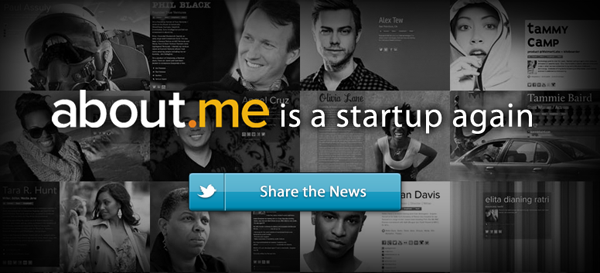
About.me announced that it was leaving AOL with the support of investors and the management team in a buyback that would take the personal identity platform private and back to its startup roots.
About.me was a quick buy for AOL, which purchased About.me for low double-digit millions according to its CEO and founder Tony Conrad. Having launched in beta for just about a year, starting in 2009, About.me launched to the public in 2010 and promptly just four days later was acquired. The exact figure wasn’t divulged but Business Insider reported that the deal was an “amazing Christmas bonus for (Conrad’s) teammates.”
If you’ve opened up an About.me account before you’d know that it builds a quick and clean personal profile site where you can publish links to your achievements and social presences from around the Web. Don’t get About.me mixed up with Flavors.me, however. While sporting a similar service, the latter was acquired by Moo.com (the site that offers business cards) in September 2012 and sported a more multi-faceted platform.
About.me co-founders Ryan Freitas and Tony Conrad haven’t divulged enough to make sense of the reason behind their decision. All we know is that their buyback is supported by financing from investors who have put their money in companies including Google and LinkedIn. The co-founders wrote in a blog post that to better grow About.me and garner more users, they believe that for one reason or another, “building About.me as an independent company is the best way to get us there.”
As part of the buyback, management won’t change hands and the existing team will remain as is “for the most part.” Based on the wording, we’re getting the impression that About.me’s management team won’t have to be cognizant of AOL’s red tape and the recesses of hierarchical politics. AOL hasn’t had the cleanest track record when it comes to mergers and acquisitions. Bebo, for instance, was sold by AOL at a tremendous loss and the earlier AOL-Time Warner deal was considered the “worst merger of all time.” TechCrunch has also had many a public spat over politics with its parent company.
The decision to break About.me away from AOL could be the best thing for the company’s future, which is focused on becoming “the Web’s starting point for identity.” The team adds, “We believe everyone will eventually have an About.me page they integrate into their email signature, add to their Twitter Bio, or embed in one of their blogs.” About.me says that it has a roadmap heavily influenced by user suggestions, so that’s a starting point to get an idea about where it’s headed. The site debuted to much hype pre-AOL acquisition, but since has become rather quiet and possible overshadowed by the various other applications hitting its exact market.
About.me notes that if you’re concerned about the future of the company and what it may intend to do with your information now that About.me has departed from under AOL’s wing, you can check out its updated terms and conditions for 2013.


